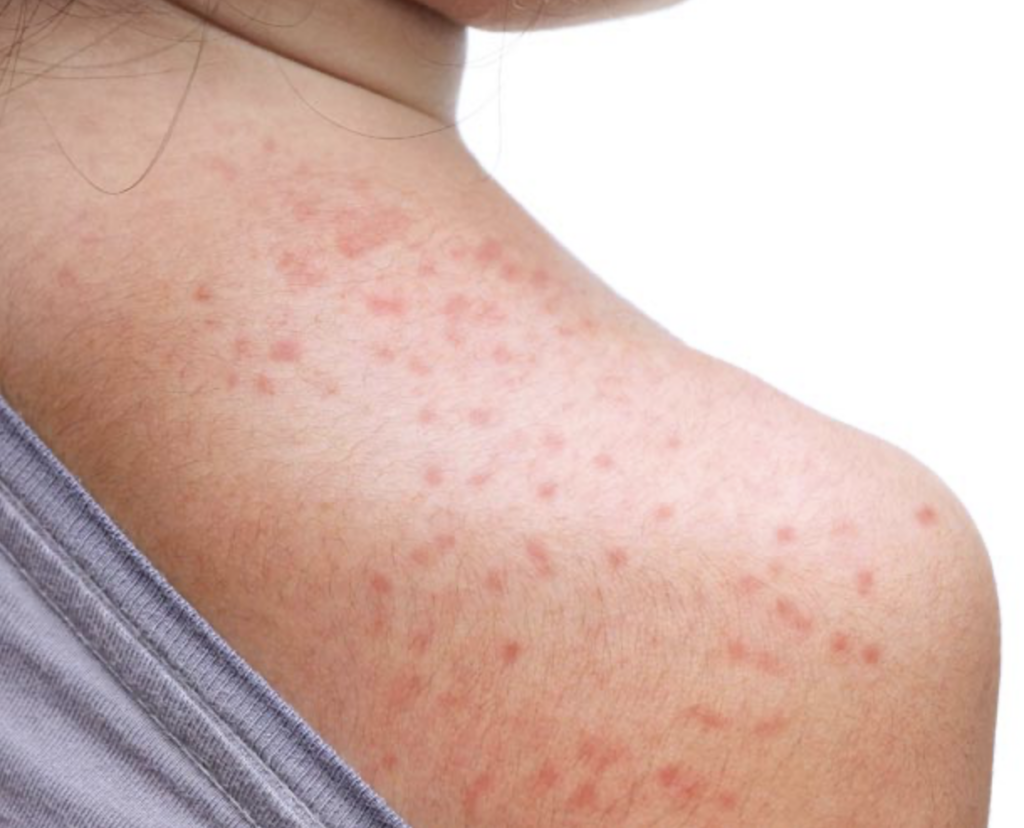Mold on Skin: Causes, Symptoms & Treatment

Mold on Skin
Can mold grow on skin?Why not? Skin is made of biodegradable material just like other materials that grow mold such as couches, carpet, or sheet rock. Because of this, skin is not immune to mold growth. Many people aren’t aware that mold on skin is even possible. However, any growth of mold on skin is considerably more dangerous than dealing with mold contamination on last night’s dinner or on your shower tiles. After all, it is growing directly on your body.
Causes of Mold on Skin
There are a variety of things which can cause the growth of mold on skin. Depending on what caused the mold growth, the treatment varies accordingly. Here are the 3 main causes for the growth of mold on skin:
- Diet; too much yeast, etc.
- Excess moisture from humidity or improper drying procedures.
- Skin reaction from infection or other outside source.
Skin Moisture Prevention
Mold needs moisture, warmth, and fuel to reproduce and grow. The human body is an optimal place, as our body temperatures are high, and our skin is made of biodegradable, slightly porous material that mold spores love to attach onto. If your skin has too much moisture, it will be the perfect environment for mold growth.
If you aren’t drying your skin immediately and properly, or if the humidity levels are high, and your skin remains moist constantly without being able to dry out, it would only make sense that mold spores would begin to reproduce.
Keeping on top of moisture problems will help prevent fungal growth on your skin.
Be sure to keep the humidity levels, especially in your home, low and dry. Be sure after bathing, that all areas especially the warmer places like armpits, are completely dried.
Wear loose fitting, breathable clothing that allows excess moisture and perspiration to evaporate. If you notice new or strange marks on your skin, always get a professional to assess it right away. A skilled dermatologist will be able to determine if it is indeed mold on skin
High Yeast Diets Increase Chances of Mold
Skin is the largest organ of the human body. It also tends to be the last place on your body that shows signs of inner problems. Many of your body’s waste products are secreted out of your skin through sweat glands and pores. Many times, if too many yeast containing products are consumed, there is an over abundance of yeast in the blood, which can result in yeast infections, or in an outbreak of mold on the skin.
Always consume a healthy, balanced diet that doesn’t contain high amounts of yeast. If you do notice mold growth on your body, always seek professional help from a licensed dermatologist. A dietitian may be required to assess and modify your diet.
Infection
If your body is already dealing with a problem, such as an infection, reduced immune system, or other problems, your natural defenses are compromised, and mold is more likely to get a foothold on your skin.
Treatment for Mold Growth on the Skin
Depending upon what the causes of mold growth are, there are several treatments options available. Always start with a small area to make sure you don’t have any adverse reactions, and consult with a doctor for persistent or severe cases.The following treatments are suggestions from different individuals who have attempted to deal with the growth of mold skin. If you are uncertain, always seek advice from your healthcare provider or dermatologist.
Disinfect Clothing and Bedding
Clothing can hold fungus or mold spores, re-introducing them even after you have cleaned your skin. Be sure to wash clothing in hot water after each wearing and also wash bedding as often as possible. If sheets are not being washed daily in hot water, wear clothing over the infected area to prevent retransmitting the fungus each night at bedtime. For items that directly touch the infected area, such as socks, soak them in vinegar for 15 minutes before washing.
External Topical Treatments
There are a number of different things that have been suggested for topical use on mold growth or fungal breakouts on the skin. Here is an easy to read list of ideas for semi-fast relief :
- Dandruff shampoos for scalp
- Athlete’s foot creams
- Daily vinegar baths or apply packs soaked in vinegar water for 15 minutes.
- Daily apply geranium essential oil in an olive oil base.
- Apply a black walnut tincture daily with cotton.
- Yeast infection medication cream like Monostat that can be found at most local drug stores.
- Lavender oil
- Coconut oil
- Selsun Blue
- Tea tree oil
- Wash everyday with extra strength neem soap and an exfoliant.
- Scrub with crushed Bayer aspirin. (salicylic acid kills fungus)
- Apply coptis powder mixed with Pau D’Arco tincture as a paste over the effected area.
- Clay Poultice – Purchase clay in powder form from a local health-food store, soak in water in a glass container for 2 hours, then apply directly to the skin or in a poultice.
[Advice from a Poster on Tribe.com]
Here is some advice from a poster on Tribe.com that may bring some insight on how to deal with mold on skin. This has not been vetted by a health professional, but it may help you if you are dealing with a mold outbreak.
Treatment needs to be done for at least 4 weeks daily for it to work completely.1. Make a mix of 1/2 witch hazel, 1/4 distilled water, and 1/4 apple cider vinegar. Use this on and around any areas of skin having issues. Apply with fresh cotton swab or cotton balls. DO NOT DOUBLE DIP!!! Meaning if the cotton swab/ball has touched your skin, you do not dip it into this mixture because it will contaminate it with the fungus. Use morning and night after washing face and allow to dry completely before using any other products. 2. Make a sea salt scrub by filling a small glass jar that has a tight closing lid about 1/2 way with sea salt. Pour olive oil on top and let it penetrate (stir a little if you need to), till all the salt is moistened, but not swimming in oil. Use once or twice a week before bed by taking out a bit with your fingertips and rubbing it onto affected areas. Scrub-a-dub-dub, rinse thoroughly with warm water and apply witch hazel/acv astringent. Once again, don’t double dip. If you need more wash and dry your hands thoroughly before getting more from the jar. Keep in mind that: – using products like makeup can reinfect you repeatedly so you might want to lay off makeup during treatment (if you use any) and replace it afterwards – lotion can spread it around so probably a good idea to not do that during treatment either (if you can I would try Rose’s suggestion of coconut oil as a moisturizer during treatment if you need it, extra virgin) – Also throw away any loofahs or scrubbies, or anything else you use on your body regularly. – For the 4 weeks you undergo treatment you need to use a new, freshly laundered wash cloth. – Also, add apple cider vinegar or white vinegar to everything you launder in hot water, about a cup per load.
Internal Treatments
In some cases, topical mixtures just will not permanently rid your skin of mold growth. In these cases it is entirely possible that the growth is more than just a “fungal infection on the skin.” Other measures may need to be taken.
- A diet lifestyle change may be the best option.
- Eliminating completely yeast, sugar, and wheat.
- Trying a yeast cleanse while stopping from eating any more yeasts.
- Consuming a Pau D’Arco tincture daily
- Drinking a glass of cranberry juice a day.
Conclusion
Mold is sneaky. It can grow quickly in the most inappropriate places, and one of those places just so happens to be your skin. Mold on skin is no joke. It can cause symptoms such as redness, swelling, itching and pain. If left unattended, mold on skin can create serious complications. Prevention is always best when it comes to preventing mold, but because it is sneaky, you may find yourself in a situation where mold has snuck into your life. If you think you have mold growing on your body, you can try some of the treatments listed above or see your doctor for suggestions and remedies.


